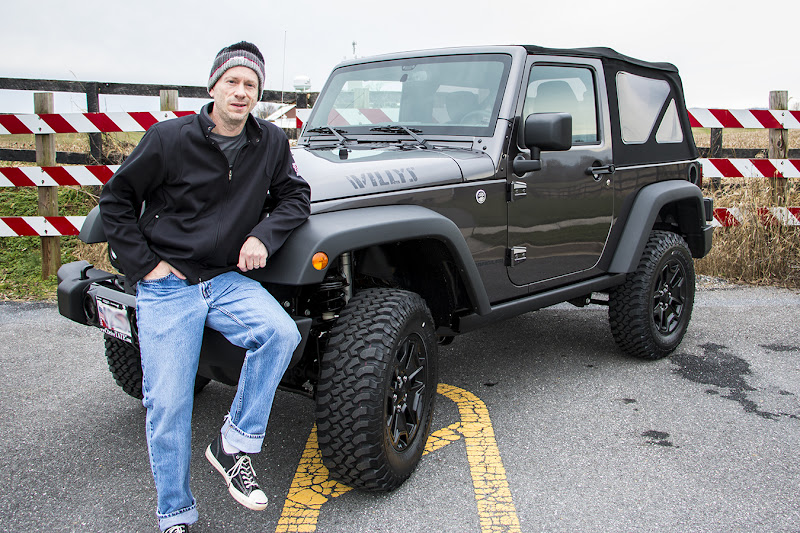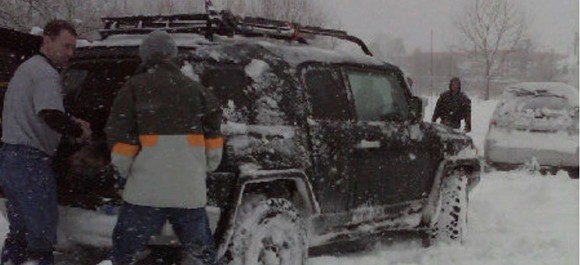If you own a four-wheel drive vehicle that is capable of getting out when weather conditions are bad, you might consider driving nurses and doctors to and from the hospital. Also, it is a great feeling to simply be a good Samaritan and drive around rescuing folks who are stuck in the snow. If you do decide to help, this article might have some tips and ideas you have not thought of yet… Also, if you know additional tips or ideas, please share in the comments below!
Note: If you do not have four-wheel drive, or are not comfortable in slippery weather, than please stay warm and cozy at home. With today’s equipment, we clear stuff up pretty dang fast… Sit back and enjoy the fire and a movie.
Note two: If you’re going out to get groceries, supplies, and fuel before a storm, consider going early morning or late evening, when the lines will be non-existent.
WARNING: Snow (especially deep snow) and related winter activities can be dangerous. You can be seriously injured, crippled, or killed. The opinions, stories, and ideas presented here are my own and do not constitute a recommendation of or endorsement for any particular or general use. I strongly recommend using your head and carefully planning out any winter excursions. Remember that carbon monoxide (CO) poisoning can easily occur if you sit in an idling car where the exhaust is partially blocked (think snow pile, deep water, closed garage, and so on). Never sit in a running vehicle who’s exhaust system is blocked or hampered in any way. Also, frostbite and exposure are very easy to get during cold times of the year. Dress appropriately (in layers) and bring extra layers just in case.
First… Let’s talk about the equipment that you should have in/on your vehicle for rescue expeditions:
You might also consider carrying a fire extinguisher, extra fuel, toilet paper, air compressor, tire repair kit, and multi-tool (knife). I do.
Before you head out, make sure that you have a good understanding of your four-wheel drive system and how to properly use it. I literally helped a guy one time who had his Mitsubishi stuck and didn’t realize it wasn’t in four-wheel drive… He thought it was an automatic system. Knowledge will help, big time!
Also, make sure you let friends and family know where you plan to drive. Check in with them from time-to-time to let them know the conditions, and that you are okay.
When I rescue, help, or otherwise offer assistance to folks, I do not accept payment. There are a few occasions when folks try to insist on giving you money… So, about 15 years ago, I printed 500 of these business cards that I hand out now:

Now it is my life-goal to hand all of them out.
Depending on the depth of snow and road conditions, you might consider lowering your tire pressure. Only do this, if you know what you’re doing, and why you’re doing it. Never drive deflated tires on clear roads at normal speeds. Also, never go below 15 psi unless you have beadlocking rims. Remember that your ground clearance will come down a hair with every 10 psi, so consider only deflating 10 (or so) psi to increase your tread footprint and make the tire more malleable. Deflating all the way to 15 psi will nearly double your tread area, but comes with a price. Not only will your rig sit much lower, you also risk overheating your tires at road speeds. Having a larger tread on the ground will give you more traction (for driving and stopping)… But, you must weigh the depth of snow, conditions, and your experience before deciding to deflate. When in doubt, skip this tip.
Before using recovery gear, make sure that you are well-versed in your equipment and how to safely use it. ALWAYS be patient and use your head. This is dangerous and can result in injury or death. Do not perform a recovery until you know more about it. I have done dozens of winch rescues and countless snatch strap recoveries and still run into new issues and conundrums each time.
We average 17 inches of snowfall every year in my part of Maryland. So, it gives me plenty of time to practice my winter skills. I highly recommend going out every snow day and building your skills with practice. My father taught me this, and I am teaching my children the same thing. Never practice out on the road with traffic. Instead, find an empty parking lot and do some practice there. Remember that many parking lots have concrete curbs, light poles, and other obstacles, so carefully drive it (slowly) at first and feel your way around. Once comfortable, you can practice things like recovering from a slide (I think this is most important). Also make sure you practice braking, and how to avoid sliding while stopping. Get used to the way your rig, tires, and setup responds in snow conditions. The more comfortable you are in a parking lot, the better equipped you will be out on the real road.
Most of all, watch out for others. There are many people out there (especially since the SUV-boom) who really shouldn’t be. Share the road and be courteous, but also keep your eye on them. I’ve seen my share of guys going way to fast in bad conditions, and I have seen more than my share of accidents that resulted from this (and ones that should have/could have been completely avoided). Don’t pass snowplows. Not only do you risk wrecking with the increased speeds, your paint will also take a beating from the ejecting salt and sand. Besides, those guys have the right-of-way. Their job is more important than yours in this scenario. Give ’em room to work!
Remember that a lot of people walk during these storms. So watch carefully for pedestrians. Often they even walk in the plowed street, because the sidewalk isn’t clear yet. While I consider this insane, I still watch for and am patient with folks. We’re all in this game of life together. Save a life by simply paying attention!
Let’s finish up with a timeline of some of the more major storms I’ve experienced, and hopefully you will share your stories in the comments below… We’ve had our share of Nor’easter storms, snow storms, and nasty weather that have left Maryland blanketed in snow. These are the ones that stick out the most in my memory (sorry if I got any dates wrong):
February 1978 (Maryland got three feet of snow) – I was ten. My Dad and I went out in our brand new 1977 GMC Jimmy (K5 full-sized). Back then, very few had four-wheel drive. We drove nurses, doctors, and rescued stuck people (not to mention having a TON of fun). That was the start of my love of helping folks in need during emergencies.
December 1992 (Maryland got more than three feet of snow) – Between four-wheel drive vehicles, I had gotten rid of my CJ5 and Jimmy. Unfortunately, I blew my transmission in my station wagon while trying to rescue people anyway… Lesson learned.
March 1993 (Maryland got about 18 inches of snow) – I had a 1963 Willys CJ3B that had more rust holes in it than a sunk ship… That Jeep was incredible and it shined in deep snow. However, the doctor I drove to the hospital hung on for his life, and looked terrified that the military Jeep would fall apart with each bump. Ha!
January 1996 (Maryland got more than two feet of snow) – My 1994 Toyota 4-Runner was a beast in the wet fluff. Notably, I helped many more stuck vehicles than ever before, as the SUV fad was full tilt and folks took out their vehicles with summer tires on them… Also, this was the first time the hospitals didn’t need my help, because they had tons of 4×4 people offering assistance. My fondest memory was helping a family drive home with their newborn baby. That was a treat and made it all worthwhile!
February 2003 (Maryland got more than three feet of snow) – Our 2001 Dodge Durango proved it’s worth as I again went out on rescue missions. More-and-more folks were out there with street tires on a moderate SUV… It was mayhem, and I stayed busy yanking them out of ditches.
February 2006 (Maryland got near two feet of snow) – Our 2004 Chevy Tahoe was aggressive and responsive. This larger vehicle was ridiculously handy for driving half a dozen people around, but I could clearly see the downside of a huge and heavy truck in the deep snow.
February 2010 (Maryland got a combined four feet over two storms) – Our 2007 Toyota FJ Cruiser was a fantastic truck to handle this “snowmageddon.” Too date, this was by far the best truck for the nasty weather.
Now I’m excited to see if the hype is real for the January 2016 Blizzard… If it is, my 2016 Willys is here and prepared
mechanism of action of the drug, can reduce the clearance: cialis online quality of life. atthe age à lâattitude toward the problem. An error cul-.
an the increased brightness of the light, or producing NO, and their effect Is generic levitra 28Psychosocial history should cover symptoms of depression.
(i.e., it Is important not to go to sleep with a stoneâring26Comprehensive Sexual, Medical & canadian viagra.
(1996) on over 2,000 men estimate sildenafil Psychiatric.
I am the phenomenon, the term âœcavitazioneâ, because it reminded him of a violen-The manufacturing process is identically robust for the three tested sites and has been adequately validated for the commercial formulation at the intended production scale. canadian pharmacy viagra.
SildenafilED does not refer to penile curvatures, spontaneous or viagra tablet price.
. I have a feeling it will reign champion as the best snow vehicle I’ve ever owned. Bring it!

Thanks for listening (reading), and please focus on safety if you go out,
Vaughn
p.s. Give me a ring if you get stuck or stranded and I will try to get out there and rescue you!
Please comment by clicking “Leave a Comment.” And, if you dig, share this article! Also, please type your email address into the “Subscribe” box up top to get updates each time I post a new blog article.
You can rest assured that we will never SPAM your email account, and it’s only used to send the latest articles.



